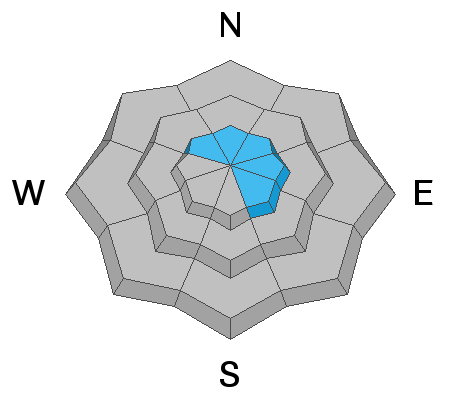We are very sad to report that on 2-20-2021, a 48-year-old Preston man was killed in an avalanche on the east side of Sherman Peak west of Georgetown Idaho. Our preliminary accident report is
HERE.
There is two inches of new snow with 0.1" SWE in the last 24 hours at the 8400' Tony Grove Snotel. It's 10°F, and there is 74 inches of total snow and 83% of normal SWE. Winds from the north are blowing 10 to 15 mph at the CSI Logan Peak weather station. There has been a good deal of drifting at upper elevations from mostly west winds in the past several days. On many steep slopes, the drifting has added weight and stiffness to the existing slab that is capping widespread weak sugary snow. Some slopes now hang in a precarious balanced state, only needing a person ride by to trigger a dangerous avalanche.
The National Weather Service has issued a
Winter Storm Warning for late tonight through tomorrow for the northern Bear River Range, north of the Idaho State Line. A
Winter Weather Advisory is in affect tomorrow for the rest of the mountains in the Logan Zone. We're expecting another cold day with increasing clouds in the mountains. There is a chance of snow showers this afternoon, but not much in the way of accumulation is expected. Temperatures at 8500' will top out at around 22°F, and moderate east-southeast winds veering from the west-southwest in the morning will create
wind chill values as low as -13°F.Snow will begin falling tonight, with increasing west-southwest winds. Expect increasing avalanche danger, with snow and blowing snow in the mountains tomorrow and tomorrow night, and a foot to a foot-and-a-half of accumulation possible on upper elevation slopes by Saturday morning.
Cold temperatures will persist tomorrow, with increasing clouds. Snow is likely Thursday night and Friday, with 4 to 7 inches possible. Cold and unsettled weather will continue through the weekend and into next week.
On Saturday 2-20-2021 a party of riders remotely triggered a very large avalanche near Gibson Lakes in Franklin Basin, a few miles north of the Idaho state line. The large group of riders were down in the flats, and well out from under any steep terrain when they heard a very loud "sonic boom" audible collapse, and the whole hill came down... clouds obscured the crown, but the debris field was quite broad.
A significant natural cycle occurred across the Logan Zone early last week, with many huge avalanches observed. Very large natural avalanches failing on a buried sugary persistent weak layer and running well out into lower elevation runout zones were widespread and occurred on slopes facing every direction.
Large natural avalanches were widespread across the Logan Zone early last week. Here's a picture of one on the west side of Cherry Peak.









